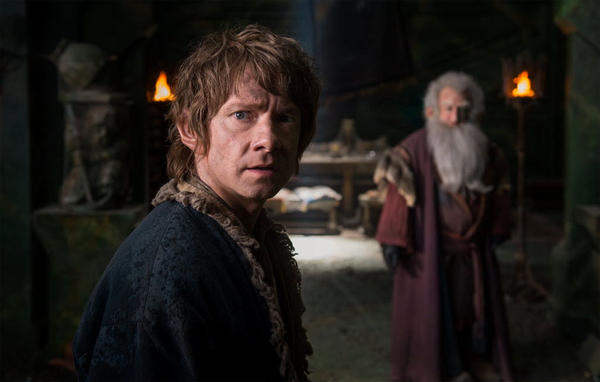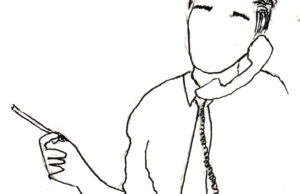The Hobbit: The Battle of the Five Armies Review

The epic stories of Middle Earth have come to an end with “The Hobbit: The Battle of the Five Armies,” a decently spectacular but slightly controversial installment.
To continue Smaug’s (Benedict Cumberbatch) furiosity after the confrontation by Thorin’s company in “The Hobbit: The Desolation of Smaug,” the film begins with the dragon Smaug destroying Lake-Town and being killed by Bard the Bowman (Luke Evans). As many of Lake-Town’s residents were killed by Smaug, the remaining citizens persuade Bard to ask the dwarves for their promised gold. Fili (Dean O’ Gorman) and Kili (Aidan Turner) leave for the Lonely Mountain to reunite with the rest of their company and Bilbo (Martin Freeman). Meanwhile, Thorin gets “dragon sickness,” becoming more and more obsessed with gold and with finding the Arkenstone, the highly valued Durin king’s stone and symbol of dwarven power, which Bilbo has been hiding in his coat the whole time. A little drama later, Thorin (Richard Armitage) and Bilbo have an unexpected but really, really cute conversation about an acorn. Eventually, the Arkenstone brings upon a metric crapton of drama and battle that becomes the basis of the movie.
The main problem with this film was its loose ends. In the midst of the fight between five armies, there were terrifying, gigantic worms shooting up from beneath the ground, killing many – but they only appeared for 30 seconds, and were almost completely unexplained. After that they were not shown again, leaving viewers puzzled. Thranduil, Legolas’ cool warrior dad, also mentions Legolas’ mother with no resolution. This was strange because Legolas himself wasn’t even in the book version of “The Hobbit,” so why mention and not elaborate on Legolas’ mother? I believe it could have been executed better, especially as Legolas’ personality was very inconsistent with his demeanor in the book and film versions of “The Lord of the Rings.”
The worst aspect of the film was probably the end of Tauriel’s and Kili’s relationship. Tauriel was in the film for the sole purpose of having more of a gender balance, which is perfectly acceptable, but the unnecessary romance she randomly stumbled upon took away from Bilbo’s screen time (which, to be honest, is the best screen time). “The Hobbit” is called “The Hobbit” for a reason, and Bilbo, as the heart of the film, should have been focused on more. The spontaneous elf/dwarf love of Tauriel and Kili was not in the book, and it distorted the the dwarves’ loyalty to Thorin. It also took away from the importance of the friendship of Legolas and Gimli in “The Lord of the Rings.”
Perhaps one of the best moments in the film trilogy was the final battle between Thorin and the orc Azog. The battle commences on an ice lake, which is absolutely incompatible with Azog’s weapon, a flail. The flail causes the ice to break in several areas, eventually leaving the two warriors on a small island of ice. Thorin is able to push Azog underwater, and the viewer’s heart soars and sighs at this moment of “victory,” – it seems that Thorin will be safe. Then, a strange sense of panic kicks in as Azog’s body floats beneath the ice and he emerges to once again attack Thorin. However, this scene was yet another addition to the long list of “things in the film but not in the book,” as Kili and Fili should have fought with Thorin. But although this scene was inconsistent with the book, it was well done.
The strangest characteristic of the trilogy as a whole was certainly Bilbo hiding the ring from the dwarves. In the book, the dwarves and Gandalf know of the ring the whole time and love Bilbo even more so because of it. It is possible that the concealment in the films was done to add more drama, but I personally find that it was purposeless.
“The Hobbit” is not even a trilogy. A meme online puts this frustration perfectly into words, making a play off of Bilbo’s proclamation of feeling “thin, sort of stretched, like butter scraped over too much bread” – I feel thin, sort of stretched, like one book adapted into three movies.
Besides the few problems mentioned, “The Hobbit: The Battle of the Five Armies” was effective. And by effective I mean it was the kind of film one thinks about long after it ends. It was incredibly captivating, and the moments focused on Bilbo were certainly the best. All of the actors and actresses did a phenomenal job, which cannot be stressed enough. The CGI wasn’t as fake as it could have been. And of course, thanks to director Peter Jackson, the landscape scenes were breathtakingly beautiful.
I would definitely recommend this film. It was amazing and wonderful to watch despite its few shortcomings; the inconsistencies and minor flaws mentioned can be ignored if you are blind enough to still absolutely adore Middle Earth in film like myself.
8.5/10 stars


